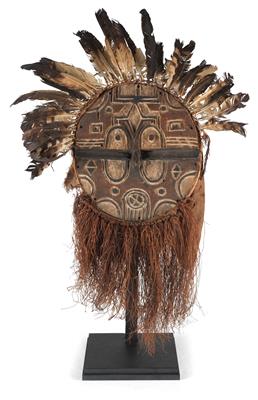Teke-Tsaye, Dem. Rep. of Congo: a large, round plank mask, called ‘Kidumu mask’. With feathers and raffia decoration.
Teke-Tsaye, Dem. Rep. of Congo: a large, round plank mask, called ‘Kidumu mask’. With feathers and raffia decoration.

The Teke-Tsaye (or Teke-Tsaayi), in northwestern Congo, had a male secret society known as ‘Kidumu’. It was in charge of all the important events in the life of the villages: initiations, weddings and funerals. At the conclusion of these rituals, a single ‘Kidumu dancer’ always performed with this disc-shaped, flat mask. The present, old ‘Kidumu mask’ displays the ‘classical’ style, with everything that belongs to that: the round disc made of lightweight wood is divided into two halves on the front side through an offset transverse line. Within this black-dyed transverse groove sits the short, protruding nose; next to it are the two eye-slits through which the dancer looks. The surfaces of the mask are fashioned in relief and coloured white (kaolin), brown and black. The relief displays two central, high oval eyes, and beneath a small, round mouth. Above the eyes sits a crocodile. Small, round, square and triangular reliefs structure the remaining surfaces, and along the rim of the mask run six semi-circular segments. On the rear, the mask has a box-shaped cavity for the face of the mask dancer, and a bite-bar, twisted many times, with which the dancer affixes the mask in front of his face. Moreover, this ‘Kidumu’ mask still retains in original everything that is required for a performance of this mask type:
the feather trim above the upper half of the mask, the long raffia beard at the lower half, as well as the old fibre fabric on the reverse, which covered the head of the dancer. Such complete ‘Kidumu masks’ are very rare; it is without damage and with good usage patina (also on the inside, on the back).
Dimensions: c. 103 cm x 70 cm (overall, with feathers and raffia beard); 44 cm x 38 cm (the wooden mask alone). First half to mid-20th century. (ME)
Provenance:
Pursuant to information supplied by the consigner, acquired in the Congo ‘in situ’ in 1973. Austrian private collection. Exhibited: ‘Ursprung und Moderne’, Linz, 1990, exhib. cat. no. 2.184.
Lit.:
‘Bateke’ by M.-C. Dupré and E. Féau, ill. 203; ‘Die Kunst des schwarzen Afrika’ by Kerchache, Paudrat, Stephan, ill. 166.
Esperto: Prof. Erwin Melchardt
 Prof. Erwin Melchardt
Prof. Erwin Melchardt
+43-1-515 60-465
erwin.melchardt@dorotheum.at
20.02.2017 - 14:00
- Prezzo di partenza:
-
EUR 7.000,-
Teke-Tsaye, Dem. Rep. of Congo: a large, round plank mask, called ‘Kidumu mask’. With feathers and raffia decoration.
The Teke-Tsaye (or Teke-Tsaayi), in northwestern Congo, had a male secret society known as ‘Kidumu’. It was in charge of all the important events in the life of the villages: initiations, weddings and funerals. At the conclusion of these rituals, a single ‘Kidumu dancer’ always performed with this disc-shaped, flat mask. The present, old ‘Kidumu mask’ displays the ‘classical’ style, with everything that belongs to that: the round disc made of lightweight wood is divided into two halves on the front side through an offset transverse line. Within this black-dyed transverse groove sits the short, protruding nose; next to it are the two eye-slits through which the dancer looks. The surfaces of the mask are fashioned in relief and coloured white (kaolin), brown and black. The relief displays two central, high oval eyes, and beneath a small, round mouth. Above the eyes sits a crocodile. Small, round, square and triangular reliefs structure the remaining surfaces, and along the rim of the mask run six semi-circular segments. On the rear, the mask has a box-shaped cavity for the face of the mask dancer, and a bite-bar, twisted many times, with which the dancer affixes the mask in front of his face. Moreover, this ‘Kidumu’ mask still retains in original everything that is required for a performance of this mask type:
the feather trim above the upper half of the mask, the long raffia beard at the lower half, as well as the old fibre fabric on the reverse, which covered the head of the dancer. Such complete ‘Kidumu masks’ are very rare; it is without damage and with good usage patina (also on the inside, on the back).
Dimensions: c. 103 cm x 70 cm (overall, with feathers and raffia beard); 44 cm x 38 cm (the wooden mask alone). First half to mid-20th century. (ME)
Provenance:
Pursuant to information supplied by the consigner, acquired in the Congo ‘in situ’ in 1973. Austrian private collection. Exhibited: ‘Ursprung und Moderne’, Linz, 1990, exhib. cat. no. 2.184.
Lit.:
‘Bateke’ by M.-C. Dupré and E. Féau, ill. 203; ‘Die Kunst des schwarzen Afrika’ by Kerchache, Paudrat, Stephan, ill. 166.
Esperto: Prof. Erwin Melchardt
 Prof. Erwin Melchardt
Prof. Erwin Melchardt
+43-1-515 60-465
erwin.melchardt@dorotheum.at
|
Hotline dell'acquirente
lun-ven: 10.00 - 17.00
kundendienst@dorotheum.at +43 1 515 60 200 |
| Asta: | Tribal Art |
| Tipo d'asta: | Asta in sala |
| Data: | 20.02.2017 - 14:00 |
| Luogo dell'asta: | Wien | Palais Dorotheum |
| Esposizione: | 11.02. - 20.02.2017 |
